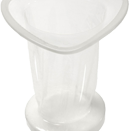VAGINAL RING
A Vaginal Ring is a form of contraception that is transparent, flexible, thin ring that is inserted into the vagina by the user. It is about 5.08 cm in diameter and 4 mm thick. The ring is left in for 3 weeks or 4 weeks at a time. If worn for three weeks, the vaginal ring is taken out, and another one is not inserted for a week. The vaginal ring can also be worn for 4 weeks before inserting a new one, when this is done the monthly period will not occur. During the time that the ring is in it slowly releases estrogen and progestin hormones into the body. These hormones stop the woman ovulating and will thicken the cervical mucus. This creates a barrier to prevent sperm from fertilizing an egg. Each Vaginal Ring provides one month of birth control. The Vaginal Ring is 98-99% effective as birth control.
It does not protect against reproductive tract infections, including HIV/AIDS.
Women who have following conditions cannot use a vaginal ring for contraception:
*History of heart attack or stroke
*Chest pain
*Blood clots
*Severe high blood pressure
*Diabetes with kidney, eye, or nerve complications
*Known or suspected cancer
*Liver tumors or liver disease
*Headaches with neurological symptoms
Some common, but minor, side effects are:
*Vaginal discharge
*Vaginal irritation
*Headache
*Weight gain
*Nausea
*Irregular bleeding
*Breast tenderness
*Mood changes
Some rarer, but more dangerous side effects are:
*Abdominal pains (severe)
*Chest pain or shortness of breath
*Headaches (severe)
*Eye problems, such as blurred vision
*Severe leg or arm pain or numbness
THE COMBINED ORAL CONTRACEPTIVE PILL
The Combined Oral Contraceptive Pill more commonly known as 'The Pill' is the most popular type of birth control. One pill is taken every day for 21 days. After twenty-one days,



Informative, but...
Why did you take only female contraception into consideration? Was it a requirement?
2 out of 2 people found this comment useful.